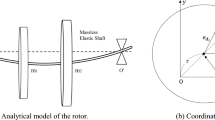Abstract
In a correctly designed magnetic reducer, the electromagnetic moments depend on the torque angles, with the dependence being near-sinusoidal. If the active zones have a nonoptimal geometry, the electromagnetic moments have high-frequency oscillations caused by the reaction moments, resulting in discrete locking or sticking of the fixed rotors. Under unfavorable conditions, the amplitudes of the pulsations may be comparable with the maximum or tilting electromagnetic moment value. The electromagnetic moments of a magnetoelectric gear reducer (MER) are calculated by the energy method based on trigonometric-series expansion of the specific magnetic conductance of the air gaps and the MMF of the magnets. For this purpose, integral expressions are found for the magnetic field energies in the air gaps which depend on the rotational positions of the rotors with respect to the fixed stator magnets. For arbitrary selected harmonics of the magnetic conductance of the air gaps and the magnets’ MMF, the conditions are determined for the orders of the above harmonics and the number of the cogs and poles at which the integrals for the magnetic field energy will be different from zero. Such an approach allowed deriving equations for the basic electromagnetic moments and the concomitant stray moments. If the found conditions are not met, the extraneous harmonics of the electromagnetic moments are eliminated. Selection of a number of modulator rods equal to a prime number is a radical means of eliminating higher harmonics of the electromagnetic moments. If a prime number of the rods cannot be selected, such numbers of the stator pole pairs should be selected at which the presence of higher harmonics of the electromagnetic moments is possible at the highest order values of the harmonics of the magnetic conductance of the air gaps and the MMF of the stator and rotor magnets.
Similar content being viewed by others
References
Dergachev, P.A., Kiryukhin, V.P., Kulaev, Yu.V., Kurbatov, P.A., and Molokanov, O.N., Analysis of a double-stage magnetic multiplicator, Russ. Electr. Eng., 2012, vol. 83, no. 5, p. 271.
Jiabin Wang, Kais Atallah, and Carvley, S.D., A magnetic continuously variable transmission device, IEEE Trans. Magn., 2011, vol. 47, no. 10.
Afanas’ev, A.A., Reactive moment of de-energized valve motor with permanent magnets, Elektrichestvo, 2011, no. 3.
Afanas’ev, A.A., The way to calculate multiplier, Elektrichestvo, 2013, no. 10.
Afanas’ev, A.A., Efimov, V.V., and Nikitin, V.M., Numerical mathematical simulation of one-step magnetic gear, Elektrichestvo, 2014, no. 4.
Author information
Authors and Affiliations
Corresponding author
Additional information
Original Russian Text © A.A. Afanas’ev, 2016, published in Elektrotekhnika, 2016, No. 12, pp. 20–25.
About this article
Cite this article
Afanas’ev, A.A. The higher harmonics of the electromagnetic moments of a magnetoelectric reducer. Russ. Electr. Engin. 87, 666–671 (2016). https://doi.org/10.3103/S1068371216120026
Received:
Published:
Issue Date:
DOI: https://doi.org/10.3103/S1068371216120026




